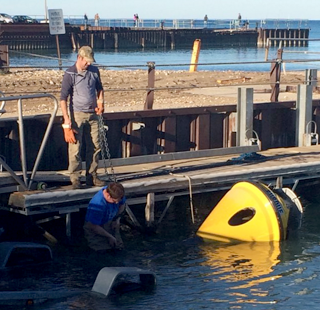
Every year as winter approaches, the Michigan City and Wilmette buoys are taken out of Lake Michigan. So we were wondering, what happens to them? Where do they go? The best people to tell us about the off-season lives of the buoys are the individuals who work the closest with them — IISG Assistant Research Coordinator Carolyn Foley and Aquatic Ecology Specialist Jay Beugly. Here’s what they had to say.
Why do we need to take the buoy out? Why can’t it stay in all year? The main reason to take the buoy out is that the lake ices over in the winter. Weather conditions when there is not ice can also get very, very rough — rougher than what the buoy is meant to withstand (though we’re always trying to make things stronger and more rugged). The delicate instruments that take measurements also need to be cleaned and maintained to be sure we can keep transmitting the best data possible.
Is it hard to get it out? It must weigh a lot! How many people does it take? It is much easier to retrieve the buoy at the end of the year than to put it out in the springtime. You usually need one person to captain the boat and 4-5 people to help pull up the ballast weights and stop the buoy from bouncing against the boat.
Where does the buoy go once it’s out? A warehouse? A garage? The buoys are usually stored at the Purdue University West Lafayette campus, in the Civil Engineering building. Sometimes they are stored at LimnoTech’s headquarters, in Ann Arbor, MI. The buoys tend to move around during the winter, especially if they need upgrades. So keep your eye out for buoys on trailers when you’re travelling down I-65 or I-94.
Aquatic species attach easily and quickly to things in the water. Has that ever happened to any of the buoys? What did you do? Every year! Quagga mussel veligers floating around Lake Michigan are always looking for hard structures to attach to, and even if we only put the buoy out for one month, we find young quaggas that have attached themselves. Though some of the surfaces on the buoy are smooth enough to stop the quaggas from attaching, they always manage to find their way into nooks and crannies. We carefully inspect the buoy before leaving the lakeside and remove anything we see, either manually or with help from a hose.
Does the buoy get a tune-up? Like a thorough wash-down? A paintjob? The main hull gets cleaned off and all of the sensors are removed and cleaned. Depending on the sensor, this may mean an acid wash or just a good wipe down. One year we had to replace a solar panel that had completely fallen off, so we’re always double-checking that everything is where it’s meant to be.
What happens to the buoy website? Is all the archival data still available? The IISG buoy data websites go offline while the buoys are not in the water, but the main IISG buoy pages are still active. Historic data can always be found at the NDBC page (buoys 45170 and 45174, respectively), and at greatlakesbuoys.org. People who want to use the data should pay attention to notes like “Data have not been quality-checked” – if the data haven’t been quality-checked, they may contain really weird, fluke readings (like the 100-foot wave that the Michigan City wave height sensor recorded in 2014). We try to quality check the whole year of data within a few months of retrieving the buoy. People are also always welcome to email us to ask questions about the data.

